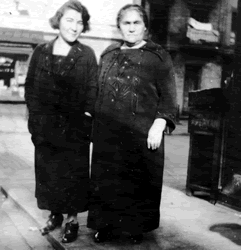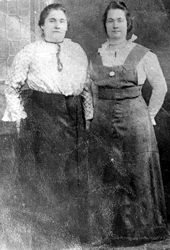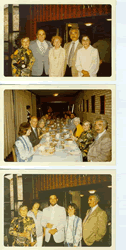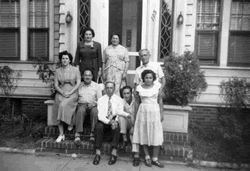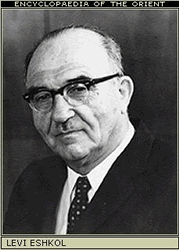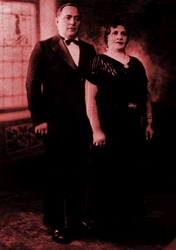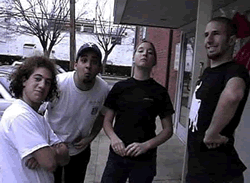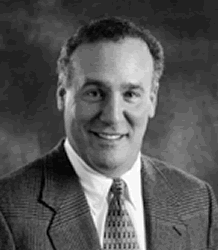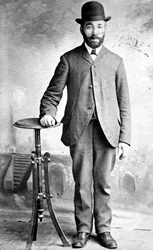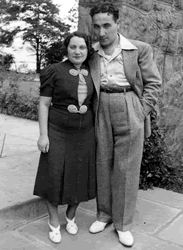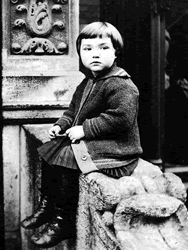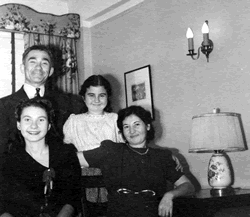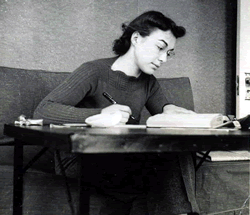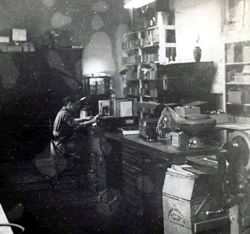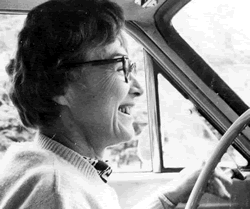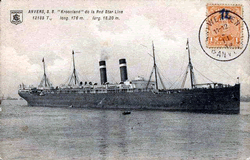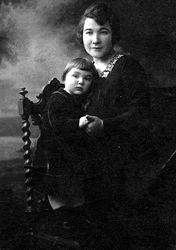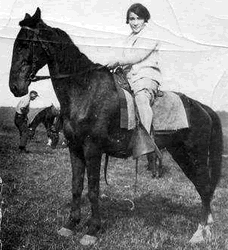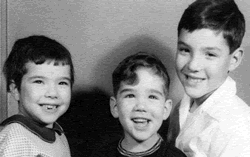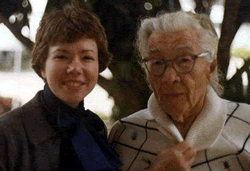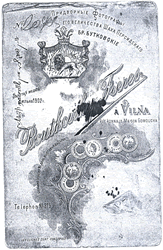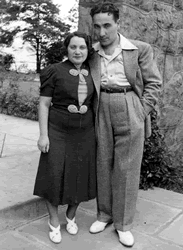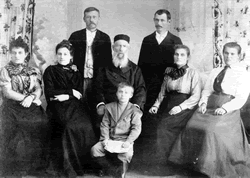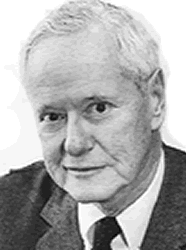Gleaned from Brooklyn Phone Directories (also Manhattan) for those years.
Enjoy!
1927 Brooklyn:
Scolnick, Jacob 1848 East 4th St ESP-0816
Scolnick, Saml 10721-109th St CLE-4882
Scolnik, D 1581 President St LAF-5851
1930 Brooklyn:
Scolnick, Bertha Mrs 379 Eastern Parkway PRO-1228
Scolnick, Jacob Dairy Grocer 305 NY Ave LAF-0111
Scolnik, D 672 Empire Blvd SLO-6743
Scolnik, Sophie Miss 1351 57th St AMB-5152
1927 Brooklyn Dir (Shkolnik - Shkolnick)
Shkolnik, A 2930 W36th St CON-5339
Shkolnik, Isidor 1189 East 29th St MID-0493
Shkolnik, Jos Contractor 729 Avenue T ESP-4062
Shkolnik, Saml 2024-82nd St BEN-6643
#sklnk-1a:
Fanny Scolnick and her mother. Probably taken on the Lower East Side of New York around the nineteen -teens
Read: The Scolniks of Kurenets
#sklnk-1b:
Fanny's mother and one of her sisters.
Read: The Scolniks of Kurenets
Anna Rickelson.
Raanan
Scenes from the Scolnik Dinner
The recipient of this year's Justice Louis Scolnik Award, Augusta attorney David Webbert, was honored at the Justice Scolnik Dinner on April 27, 2000
#sklnk-11:
Moishe (Moses) Scolnik: Fanny's father
#sklnk-12:
Fanny Scolnik Stein and her kids Eugene and Ruth
#sklnk-13:
Fanny Scolnik Stein-bookkeeper in her husband's business: Bestfit Knitting Mills. Her brother Jack Scolnik also worked there.
#sklnk-14:
Fanny's brother William Scolnik and his wife Leah (maiden name Scolnik--some kind of cousin. The are buried in Miami, Florida
#sklnk-15:
Ruth Stein (Fanny's daughter) Miner around 1920: Laura Miner's Albums
#sklnk-16:
Jack Scolnik and wife with daughters Ernestine and Dolores c.1940? Laura Miner's Albums
#sklnk-17:
Ruth Stein Miner-college or grad school Laura Miner's Albums
#sklnk-18:
Ruth Stein Miner-chemist for US Navy around 1942 in St. Louis, working on battleship paint formulas. Laura Miner's Albums
#sklnk-19:
Ruth Stein Miner 1970 or so. Laura Miner's Albums
#sklnk-20:
Fanny Scolnik Stein 1968 and 1930s (she hated to smile for the camera)
#sklnk-21:
Fanny, Jack, William,and their mother Dora/Dvosseh Scolnik came to NY on this ship in Nov 1909, tourist class, not through Ellis Island.
#sklnk-22:
Fanny and Ruth
#sklnk-23:
FANNY ON HORSEBACK IN 1920s
#sklnk-24:
Fanny's grandchildren: Miner kids c1952
#sklnk-25:
Fanny Scolnik Stein husband Sam c. 1956
#sklnk-26:
1980 Fanny Scolnik Stein and grand-daughter Laura Miner.
#sklnk-27:
Rochel (Skolnick) Weiner (Rachel in USA)
Girl = Scheine Weiner (Sadie in USA)
boy = Asie Weiner (Izzy, then Irving in USA)
Use as you will. regards,
Arnold Rabinowitz
#sklnk-28:
(reverse of #sklnk-27)
#sklnk-29:
1.Fanny's brother William Scolnik and his wife Leah
I am in the process of researching my family, and came across your
site. My uncle was William Scolnick, who was married to Leah--I came
across her picture with Willie's on the website. Leah was my father's
sister. Her maiden name was not Scolnick--she was not a cousin. Her
maiden name was Axelrod--her mother's name was Sarah, father was
Victor Axelrod. My father was her brother, Murray. She had a
brother, Seymour who was killed in Italy during WWII in 1945. Her
surviving sisters were Kate, Gladys, Eva, Sadie and Martha.
I hope this clears up something for the Scolnick family. We are
trying to find, if you have any info, my grandmother's mother--her
name was Ida or Chaya Farber. Ida was the 2nd wife of Elias Jaffe.
My grandmother's name was Sadie Jaffe Lewis. Thanks---Marcia
Axelrod Silbe
#sklnk-30:
The Skolnik family of Rehovot
My grandfather Zalman (Sam) Scolnik and his brother Jassel(?) emigrated from Kurenets to Lewiston, Maine in 1908 to join another brother Yudel (Julius) who was already there. Another brother Kalman came to the U.S. about 1890 and was married to a Mary Gurewitz
I found the family in the 1930 census;
Samuel Scolnik Age;40 BirthYear(1930, '40');1889 Russia Head White Lewiston, Androscoggin, ME married at age 25 came to the country in 1910? clothing
Sadie M Scolnik Age; 40 BirthYear(1930, '40');1889 Wife Lewiston, Androscoggin, ME married at age 25 dresses maker
Hilda R Scolnik Age;14 BirthYear(1930, '14');1915 Daughter Lewiston, Androscoggin, ME
Ruben Scolnik Age;12 BirthYear(1930, '12');1917 Son Lewiston, Androscoggin, ME
Rose Scolnik Age;11 BirthYear(1930, '11');1918 Daughter Lewiston, Androscoggin, ME
--------------------------------------
Joseph Scolnik Age;40 BirthYear(1930, '40');1889 came from Poland Head White Lewiston, Androscoggin, ME owned his home for $ 14,000 married at 24 came in 1908 Na peddler of clothing.
Hannah Scolnik Age;39 BirthYear(1930, '39');1890 Wife Lewiston, Androscoggin, ME married at 23 came from Russia.in 1909
Max Scolnik Age;15 BirthYear(1930, '15');1914 Son Lewiston, Androscoggin, ME
Helen Scolnik Age;10 BirthYear(1930, '10');1919 Daughter Lewiston, Androscoggin, ME
the other two brothers in 1920 census;
Scolnik, Julius 40 BirthYear(1920, '40');1879 Russia;Poland White Lewiston, Androscoggin, Maine came to the country in 1904 Na in 1914. retail Merchant dry products
wife; Bessie 38 came to the country in 1904 from Russia/ Poland Na in 1914
son; Morris 11 born in Maine
daughter; Rosie 9 born in Maine
son; William 6 born in Maine
daughter; Ida 5 born in Maine
Scolnik, Kalman age 34 BirthYear(1920, '34');1885 Russia;Poland White Lewiston, Androscoggin, Maine came to the country in 1905 Na in 1914 merchant of dry goods. Yiddish speaking
Wife; Scolnik Mary, age 30 came to the country in 1907 from Russia/ Poland Na in 1914
son; Samuel 7 born in Maine
son William 6 born in Maine
son Alex 2 years and six months born in Maine
Levi
Eshkol [nee Shkolnik]
By Prof. Ofra Nevo, Eshkol’s daughter http://research.haifa.ac.il/~eshkol/roots.html
Levi Eshkol was born in 1895 in the Ukrainian village of Oratovo (near
Kiev). His mother, Devorah, came from an energetic business family that
leaned towards Hassidism. His father, Yoseph Shkolnik was a son of a
bookish, religiously devout family, that leaned towards the "Mitnagdim",
the Lithuanian stream in Judaism. The seeds for the two traits - the
business and the spiritual, finances and quotes from the Sages, the
value of work and Biblical verses - were planted in him at home.
Home was in the midst of forests and orchards. The family traded in
lumber, cattle and fish, and operated flower mills. A family accustomed
to both industry and agriculture. His mother, Devorah, had nine sons
and one daughter, of whom only four boys survived. Levi was the second.
At the age of four he and his brother Lippa were sent to their grandfather,
to study in the "Heider". Later on he studied the Talmud,
and students-tutors were hired to teach the two teenagers secular subjects.
Two years after the Bar Mitsvah he applied to a High School in the region,
but was rejected because of the restrictions on Jewish students. He
traveled to the Hebrew Gymnasium in Vilna, where he joined the "Young
Zionists" organization.
Inspired by Yoseph Shprinzak (after 1948 - the first speaker of the
Knesset) - a leader of "Hapoel Hatsair" - Levi decided to
"make Alyiah" - to go to Israel. Levi declined his parents
financial support. "Only if I come empty-handed will these hands
be ready to work..."
During World War I, he volunteered for the Jewish Legion of the British
Army, and joined the group which founded the settlement of Degania Beth.
Eshkol later worked in the Histadrut Labor Federation's Agricultural
Center. He participated in the establishment of "Mekorot," Israel's water utility, in 1937, and served as its chief executive until
1951.
In 1940, he became a member of the Haganah, and in 1947 he organized
the recruiting drive for what became the Israel Defense Forces. With
the establishment of the State he became the first DirectorúGeneral
of the Ministry of Defense, in effect the supplier of the material which
kept the Israeli army in the field. He also became the head of the World
Zionist Organization/Jewish Agency's Settlement Department in 1948.
In 1951 Eshkol was appointed Minister of Agriculture and Development
and from 1952 until 1963 he served as Minister of Finance. He remained
Chairman of the WZO/JAFI Settlement Department until 1963. Eshkol is
largely responsible for obtaining funds to develop the country, absorb
massive immigration waves and equip the army.
In June 1963, Eshkol assumed the post of Prime Minister. The high point
of his premiership was the Six Day War of June 1967. When Egypt and
Syria precipitated the crisis, Eshkol established a Government of National
Unity, relinquishing the Defense portfolio to Moshe Dayan and bringing
Menachem Begin of Herut into the Cabinet.
Eshkol found other sources of military supplies for the Israeli armed
forces, particularly in the United States, after France began its military
boycott of the Jewish state before the 1967 war. The war itself was
a vindication of his efforts at the Ministry of Defense to provide the
IDF with the best equipment available. In just six days, Israel succeeded
in liberating Judea, Samaria, Gaza and the Golan Heights, reuniting
Jerusalem, and capturing the Sinai peninsula.
Eshkol died in office on February 26, 1969 of a heart attack.
Degania/ By Asaf Agin
EARLY TIMES IN THE JORDAN VALLEY ... Herzel’s death and the
fear of pogroms in the Jewish quarters were his childhood harsh memories
. The stories of Israeli Shlihim (messengers) and reading the "Hatsfirah"
excited his imagination... The meeting with Yoseph Shprinzak, Barsky’s
letter to the members of Degania after the murder of his son Moshe,
and the news about Yoseph Zalzman’s murder while plowing a field
in Kinneret, concluded his decision...
Arriving on the ship "Heluan", in February 1914 (the last
year of the Second Alyia) he stays in the famous Haiim Baruch hotel
in Yaffo, and goes out to know the land, from Rishon Le'Zion to Ruhama.
Shkolnik was, from his first days here, a "Poel" - a Worker
with conscience, and longing for the toil of the land. Laying water
pipe for the irrigation of the orchards of Petah Tikvah was his firs
chore. After that he goes to "conquer the land" in Kalandia,
working in the olive and grape orchards, and experiencing the need of
weapons for self defense. World War I ended that chapter in his life.
Wandering with his friends they lived for a while in Rishon Le'Zion
(November 1914). That year he, with friends, founded "Kvutsat Avoda",
aiming to establish a settlement. But due to the destitution caused
by the war, he was elected to the central committee of the workers in
Judea. He dedicated himself to public work, caring for employment, income
and the basic needs of the Southern Workers. Thus was carved his public
image as the man who deciphered the code of ties between Man, Land and
Water.
In June 1918 he disregarded the dictum of his Party, "Hapoel Hatsair",
and volunteered to the 40th Jewish Battalion.
FROM KFAR URIAH TO DEGANIA. The "Avoda" group, coming
together again after the war, in Kfar Uriah, moved to a collective settlement
on JNF land, in the Jordan Valley. It was in response to a call by Yoseph
Bussel. Their settlement was designed by Shkolnik. Degania B' was born
near it's "mother", Degania A.
Shkolnik divided his time, from the first day of Degania B', between
labor during the day and public service at night. Here he built his
home, in the famous two stories shack, and developed the doctrine of
equality between woman and man.
The goal of the settlement was a diversified and technologically advanced
enterprise. Shkolnik guides the establishment of the water installation
- the beginning of irrigation, and buys the first tractor - the beginning
of cultivation.
As a delegate of "Hapoel Hatsair" to the Zionist Congress,
he is the representative of the Settlement Movement, but delightfully
he comes back to his beloved "turia" (the typical digging
tool of those days), the one he loved since Petah Tikvah, and to channel,
bare foot, the stream of water in the vegetable field. From behind the
"turia" he was called to direct the preparations for the Second
Agricultural Convention. Here his organizational talents were shown,
hence placing him in the front line of the Workers Settlement Movement,
in the "Merkaz Haklay".
SHKOLNIK AND THE SETTLEMENTS The "Merkaz Haklay" was
the mechanism that lead the Settlements during the pre-State era of
the "Yishuv". Kvotsa, Kibbuts, Workers' Moshav, Collective
Moshav, Womens' Enterprise ("Meshek Poalot"), and Seed groups
working in the Colonies, were legends materializing into reality during
the 20s (The Third and Fourth Aliah) and the 30s (the Fifth Aliah).
The friendship with his colleagues, his membership in Degania B' and
his Movement - where he was the key mover for the union of "Hever
Ha'Kvutsot" and "Gordonia", continued. He was a full
partner in the negotiations that brought forth the communal collaboration
of the settlements in the Jordan Valley.
Shkolnik found "Nir" (the financial organ of the Workers settlements)
in 1934, and with it he helped the JNF to purchase land. He was sent
to Germany to negotiate the "Ha'avarah" agreement, for saving
Jewish property in Germany. Establishing and managing "Mekorot"
(the Water Sources and Distribution Company), he used "Mekorot"
bonds as means to buy equipment for water systems with "Ha'avarah"
monies. Jewish money from Germany come, that way, to strengthen the
Settlements. "Hityashvut Ha'Eleph" and "Homa U'Migdal" that were the response to the publication of the English Pyll Committee,
and the bloody events of 1936 -1939, were the last activities in this
chapter.
In 1942 Shkolnik is called to a new front - the Secretariat of the Tel
Aviv Workers Council. That role involves him with political activities:
confronting the groups on the Right and the political opposition ("Syiah
B") within the Party. There he comes back to deal with the hardships
of the workers life. Shkolnik wins the trust of the workers, the respect
of the political right, and the esteem of his opponents within the Party
("Ahdut Ha'Avodah").
In August 1946, as acting head of the Settlement Department of the Jewish
Agency, he leads the settlement endeavors in the Negev, of which the
crown act was the founding of eleven settlements in one day, Yom Kippur.
ESHKOL OF WATER, LAND AND MAN
Eshkol's 35 years before the birth of the State were sign posts for
the active 22 years, until his death in 1969. The draining of the Hullah
swamps, the Country's Water System, 400 Moshavim, Industrial and Agricultural
developments - echo his claim: "Water for us is blood". Only
he, who knew the right linkage between Man, Land and Water, understood
the tie between man's blood and the blood of the land. The tie that
linked the water hole in Kalandia to the Eshkol Region in the Negev.
Eshkol's humor -
Turning a disadvantage into an advantage is found in a story that was
told by his Degania friend Nachum Rosenfeld: Once we were confronted
by a force of Arabs who were recruited to the Turkish army (First World
War years). They tried to steal the Kibbutz grapes. Eshkol beat one
of them. The Arab's friends grabbed Eshkol and hit him while throwing
him onto the ground. In the meantime, the Turks who lead a troop approached,
and the Arabs disappeared/ Eshkol got up, fixed his hair, and said: "Let them go to hell!" And then, with a tone of self-satisfaction:
"I've been in this country for just a few weeks and I already curse
in Hebrew and not in Russian."
Levi Eshkol - Prime Minister By Shimon Peres
Former Prime Minister
Levi Eshkol succeeded David Ben Gurion and served as Prime Minister
from 1963 to 1969. From 1963 to 1967 he was both Prime Minister and
Minister of Defense. In addition of being one of the founders of the
first Kibbutsim (Degania), he was considered a leader of Israeli agriculture,
particularly its irrigation systems, and a builder of Israel's economy.
His greater challenge was the Six Day War, conducted under his premiership
that brought Israel to its greatest military victory of three countries
- Egypt, Jordan and Syria, thus putting the Sinai Peninsula, the West
Bank, Jerusalem and the Golan Heights under Israeli control. The Eshkol
government united Jerusalem and finalized its borders as the Capital
of Israel.
The Eshkol government suggested to trade land for peace in all three
fronts, but without a response from the Arab side.
His achievements reflected his personality. He was determined, but not
obstinate. Flexible, but not submissive. Serious in action, but folkloristic
in speech. He did not demonstrate everything that he knew. He kept back
reserve of knowledge and expertise in readiness for emergencies.He understood
the art of compromise, of give and take, avoiding resentment and schism.
He knew that without compromise life is impossible: "Everybody
is in love with his own compromise"... He loved to be in the center,
but he was never jealous of the success or centrality of others. Rising
stars did not worry him. He saw them as signs of life enrichment.
Eshkol's landscape was basic: the sea and the land, the valley and the
hill, and the creative experience of man turning a naked dream-picture
into a concrete reality, in which people walk about, flourish and continue
to dream. Eshkol was drawn to such landscapes and he harnessed them
to his artistic talent, which was both lyrical and prosaic.
His Zionism was Agricultural Zionism. Furrows in the soil meant as much
to him as did the charms of philosophy, and his personality was as purposeful
as of life itself. His faith was steadfast - without moods and changes.
His faith, his sobriety, his optimism, combined with a unique sense
of humor, enabled him to draw together people of different temperaments
and conflicting energies, and direct them toward creative activities.
A good thinker, he was also a high flier, a central figure amongst the
most daring and illustrious visionaries of his people.
He contributed greatly to the strengthening of Israel's defense capacity.
He knew that in the question of defense it is vital to first recognize
the danger and only then to consider the price; to look to the demands
of tomorrow, not to the achievements of yesterday. He was not worried
by the strength of our enemies. He feared our own weakness. He exemplified
how to overcome them.
Eshkol's humor -
…would he have had the opportunity to read this book, Eshkol would
have probably said:: "Did I say such clever things?"
***"In the first several weeks after I was appointed to the Prime
Ministry, when the Prime Minister's arrival was announced during receptions
or during other public events, I used to look around and find who was
coming."
***." In response to a reporter's question about the Israeli-French
relations, Eshkol said: "The relations are so stable, that they
do not require a monthly check-up."
Abba Hillel Skolnick was born in 1850 in Plutel [near Salant], Lithuania
to Rabbi Shlomo Skolnick who was the rabbi of the town for 45 years.
He studied in the yeshiva and was appointed as a shochet. He settled
in the town of liboa and wrote poetry. As was suggested to him by shalom
Aleichem he collected and researched Proverb.
Descendants of Chaim Leib Shkolnik http://www.barrison.net/shkolnik.html
1 Chaim Leib Shkolnik b: ? in Russia d: 1941 in Russia (shtetl unknown)
+1st Wife (name unknown) b: ? in Russia d: circa 1894 in Russia(shtetl
unknown), married ? in Russia i. Esther Shkolnik b:circa 1894 in
Russia d: 1981 in Bronx County, NY .
Cause of Death - Heart Attack. Occupation -Seamstress, Homemaker.
+Abraham Oser b: May 28, ???? in Kiev Region, Russia m: ? in Massachusetts
d: November 1956 in Bronx County, NY. Children - 5. Total Descendants
- approximately 37. ii.Older Brother(?) Shkolnik - Date of birth
and date of death unknown -
cause of death was tuberculosis (word of mouth)
*2nd Wife of Chaim Leib Shkolnik:
+2nd Wife Kices Born, Married and Died in Russia - no further information,
Occupation: Seamstress. i. Shloime Shkolnik (m) b: ? in Russia
d: 1915 in Russia
+Spouse Unknown b: ? in Russia m: ? in Russia d: ?. No recorded descendants.
ii. Pesi Shkolnik(f) b: ? in Russia d: ?
+Spouse Unknown b: ? in Russia m: ? in Russia d: ?. Number of Children
- 3.
iv. Rivka Leah Shkolnik (f) b: ? in Russia d: ?
+Spouse Unknown b: ? m: ? in Russia d: Unknown. Number of Children -
2.
v.Dvora Shkolnik (f) b: ? in Russia d: ?
+Spouse Unknown b: ? m: ? in Russia d: Unknown. Number of Children -
4.
vi. Moishe Shkolnik (m) b: ? in Russia d: ?
+Spouse Unknown b: ? m: ? in Russia d: Unknown. Number of Children -
2.
vii. Burach ("Ben") Shkolnick b: ? in Russia d: ? in Winnepeg,
Canada
+Rivka Malmed b: ? in Russia m: ? d: ? in Winnepeg, Canada .
Number of Children - 1. Total Descendants - at least 5.
viii. Tobe Shkolnik (f) b: ? in Russia d: ?
ix. Marim Shkolnik (f) b: ? in Russia d: ?.
SPECIAL NOTE: Tobe and Marim Shkolnik were identical twins.
Although the information about this branch of the family is sketchy,
it is certainly a starting point. The majority of the information was
included in a letter written by the daughter of Burach ("Ben")
Shkolnik to Mimi Barrison in 1981. Her family is from Winnepeg, Canada
and it is the only branch of the Shkolnik family with whom we have made
contact. Our hope, therefore, is to eventually connect with the many
other descendants of Chaim Leib Shkolnik.
Esther Shkolnik Oser immigrated to America in the early 1900s via the
Port of Boston. According to family folklore, her older brother was
originally supposed to immigrate, but since he had tuburculosis, Esther
went in his place. Before marrying Abraham Oser circa 1914-1915, she
worked as a seamstress in a sewing factory in Massachusetts. After relocating
to Bronx County, NY with her family, Esther became a U.S. citizen circa
1938-1940.
PERSONAL REMEMBRANCES My Memories of Esther Shkolnik Oser
Written by Mimi Barrison on October 30, 1996
Once upon a time,
In a land long ago,
There lived the Great Queen Esther,
To her there's much the Jews owe.
Now, in more recent years,
The Osers had a "Queen Esther" of their own,
From whom we're all descended,
To her our existence we owe! *********************************************** Grandma
Esther, my paternal grandmother, was an integral part of my childhood.
She lived in Bronx, NY and I remember visiting her frequently (which
was fun because we got to go to the Bronx Zoo often!). On nice days,
she would always be sitting on her folding chair outside of her apartment
building, chatting with her friends. This, I believe, was one of the
reasons why she didn't want to come live with us in the suburbs - "What
would I do with myself there?" she would ask. She always took care
of herself in that little apartment - I remember one humorous tale she
told of a mouse she found in her bathroom. "It looked at me with
a great big black eye...so I flushed it!" she said with pride!
Grandma would always join us for Thanksgiving and Passover. I
remember her telling us a story in Russian, although I don't remember
what it means - I just know it started "Chum...Chum...".
Famous for her delicious blintzes, we always knew when Grandma was cooking
when heard the "clank-clank-clank" of the pots in the kitchen!
Grandma also created beautiful embroidery, cross-stitch being one of
her specialty.
Grandma always kept in touch with world events and politics, always
knowing what was going on in the world. Even when she was living in
the Nursing Home on Pelham Parkway, she was high-spirited - I remember
her waving her cane at Dad and saying "Come here, Sonny!"
*********************************************** ...And now I have
a daughter,
To her I gave your name,
Through Elayna, our new "Queen Esther",
Your legacy remains!
Shkolnik Vladimir
Minister of Energy and Mineral Resources of Kazakhstan
Personal Profile:
1973, PhD in Physics and Mathematics, Moscow Physics and Mathematics
Institute. Engineer-Physicist. 1973-92, Engineer-Physicist, Deputy Head,
Laboratory, Chief Engineer and Deputy Director, Mangyshlak Power Industrial
Complex; 1992-99, General Director, Agency of Atomic Energy; 1994-96,
Minister of Science and New Technologies; 1996-98, Minister of Science
and President, Academy of Sciences of the Republic of Kazakhstan; 1999,
Minister of Science and Higher Education; since 1999, current position.
President, Nuclear Society of Kazakhstan. 1997, Member, Supreme Economic
Council under the President of the Republic of Kazakhstan. Honorary
President, Skating Federation of Kazakhstan. 1998, recipient of the
Parasat Order. Author of more than 140 scientific papers. Interests:
economic development of Kazakhstan; human rights and environment protection.
Shkolnik (A Student or a Pupil in English) is an original Soviet
camera, which was manufactured in 1962-1969 by the BELOMO plant in Belorussia.
It is a simple box-type camera; it uses 120 film, frame size - 6x6.
Its telescopic viewfinder has a magnification of .45x and its elements
are made of plastic. The two element glass lens has a focal length of
75mm and is fixed focus; all objects from 3.5 meters to infinity come
out sharp. Permanent Address: Present
Address
77 Kirkwood Rd PO Box 24215
West Hartford, CT 06117 Atlanta, GA 30322
860-236-9969
404-275-0338 ashkoln@ece.gatech.edu
EDUCATION
Emory University, 4.0 / 4.0 GPA in CS / Math major, 3.8 overall
Atlanta, GA M.S. in Computer Science/Mathematics Expected May 2003
B.S. in Computer Science/Mathematics Expected May 2003
and Neuroscience and Behavioral
Biology
HONORS Accelerated 4 yr B.S. / M.S. program in Computer Science
/ Mathematics, Emory Honors Program in Computer Science / Mathematics,
Emory
Emory University Dean’s List National Science Foundation (NSF)
Graduate Research Fellow, 2003
Who’s Who Among American College Students, 2003
Summer Undergraduate Research at Emory (SURE) Fellow, 2001, 2002
Barry M. Goldwater Scholarship for Excellence in Science - honorable
mention, 2002 The National Dean’s List, 2000 Golden Key,
International academic honor society, will be inducted in 2003
Phi Beta Kappa, National academic honor society, junior inductee, member
since 2002 Omicron Delta Kappa, National leadership honor society,
member since 2002
Nu Rho Psi, Neuroscience honor society, member since 2001
Omicron Delta Epsilon, International economics honor society, member
since 2001
PRESENTATIONS
Shkolnik, A., Ben-Ary, G., DeMarse, T., Sweetman, I., Gamblen, P., Zurr,
I., Catts, O., Potter, S., “Neurally Controlled Robotic Drawing
Arm - MultiElectrode Array Art (MEART),” Poster presented at the
Summer Undergraduate Research at Emory (SURE) Poster Symposium, Emory
University, Atlanta, GA, August 2002.
http://userwww.service.emory.edu/~ashkoln/Potter/poster/meart-poster.pdf
Ben-Ary, G., Potter S, DeMarse T, Shkolnik A, T., Sweetman, I.,
Gamblen, P., Zurr, I., Catts, O., The current status of research into
Meart – the semi living artist – Stage 2. Biennale of Electronic
Arts Perth symposium: The Aesthetics of Care, p59-62. August 2002.
http://www.fishandchips.uwa.edu.au/images/meart/meart_i.pdf Shkolnik,
A., Edwards, D., “Is the Medial Nucleus of the Amygdala Important
for Mating in Male Mice,” Poster presented at the Summer Undergraduate
Research at Emory (SURE) Poster Symposium, Emory University, Atlanta,
GA, August 2001. http://userwww.service.emory.edu/~ashkoln/SURE2001/mna-poster.pdfACTIVITIES Russian
Club: President, Emory, 1999 - present, (previously V. P. and Treasurer) Assoc.
for Comp. Machinery (ACM) student chapter: Chair, 2002 - present
Comp2100 Computer Club: President/Founder, Emory University, 2000 – 2002
College Council: Vice President of Technology, Emory University, 2001 – 2002
Outdoor Emory Club, Emory University, 1999 - 2001
Member: AAAS since 2001; ACM since 2002
COMPUTER /
SKILLS Programming in Java, C/C++, ASP, Access/ADO, VBA, HTML,
_JavaScript, UNIX, Matlab, Pascal, Eosys, TechOptimizer
Microsoft Site Developer (MSDN) member
Familiar with personal computer hardware. Can diagnose and fix most
hardware and software problems A+ certified computer technician
(Comptia) – 100% customer satisfaction rating
Knowledgable in TRIZ (theory of inventive problem solving); certified
in Innovative Technology of Design with TechOptimizer by Invention Machine
Corp
ATHLETICS SCUBA – PADI open water certified, NAUI nitrox and
Master Scuba Diver certified Varsity Track and Field, High school
through second year of college
RESEARCH
Georgia Institute of Technology Atlanta, GA
Research Fellow (SURE 2002) 2002 - Present
· Studying plasticity in cultured neural networks
of dissociated cortical rat brain tissue, with the long term aim of
providing a robotic embodiment for the neural networks ·
Worked with the University of Western Australia to develop MultiElectrode
array ART (MEART). Data from a cultured neural network in the Atlanta
lab was sent in real-time via the Internet to a computer in Australia
at the Biennale of Electronic Arts Perth festival to control a robotic
drawing arm. http://www.fishandchips.com
Emory University
Atlanta, GA Research Fellow (SURE 2001)
2001 – 2002
· Studied the role of a specific brain structure, the medial
nucleus of the amygdala, in regulating various social behaviors of male
mice; research included electrolytic and excitotoxin brain lesioning,
ovariectomy, behavioral testing, histology, etc.
WORK
EXPERIENCE
Emory University
Atlanta, GA Computer Lab Coordinator, Graduate School of Psychology 1999 - Present
· Provide technical support and ensure that the computer
lab is functioning smoothly · Assist students and
faculty with various computer issues and multimedia equipment
Agency Management Services (AMS) Windsor, CT
ASP Programmer
1999 – 2001 · Assisted with the development
of QuoteNetworks.com, web-interfaced insurance rating software. Projects
included automating a testing process to insure the website rates properly · Programming in ASP, _VBScript, Access/ADO, HTML, _JavaScript, Java
Systems Engineer
1999 · Provided desktop customer support, helping
to maintain 600 PCs on a network · Troubleshooted
Windows NT and Novell clients, and various desktop applications
Quest Systems, Inc. West Hartford, CT
General Manager, Computer Consultant 1993-2000
· Responsible for purchasing and distributor account
management
· Built upgraded and serviced computer systems to
meet customer needs
· Worked with a team of web developer consultants
at RealDesigns.com
· Assisted with the design and development of an
innovative single-handed keyboard http://userwww.service.emory.edu/~ashkoln/keyboard
(presented at Comdex ’99)
Invention Machine Corporation Boston, MA
Engineering Intern
Summer 1998 · Developed engineering consulting
and problem solving skills
· Designed a micro-valve for use in refrigerators
made by a company in Germany VBA Programmer
1997 · Created custom software macros in Visual Basic
for Applications for use with MS Word and Excel
VOLUNTEER WORK Tutor students including elderly and disabled persons
in computers, biology, mathematics, and English language (to speakers
of Russian), largely on a volunteer basis; 1993 – present
Founded Comp2100 (now ACM), a computer club at Emory University. We
are establishing a charity program whereby donated computers are renovated
and donated through a scholarship to inner-city Atlanta school kids
Message: I made a typo in the spelling of the family name on the description of
Fanny Scolnik Stein. I must have been tired when I wrote it. The whole point
of spelling the name Scolnik when they arrived in America was so that they/we
could find each other again. For example, the Lewiston, Maine Scolniks and I
are all cousins through my late grandmother Fanny Scolnik Stein, daughter of
Wolf Gdaly Scolnik.
JEWISH NOBEL PRIZE WINNER IN
ECONOMICS
Robert Merton (1997) descendant of the Scolnik family.
From Wikipedia, the free encyclopedia. Robert C. Merton (b. 1944)

A leading scholar in the field of finance, was one of three men who, in
the early 1970s, developed the mathematics of the stock options markets.
Merton published a paper on the subject simultaneous with the publication
of another paper, reaching essentially the same conclusions, by Fischer
Black and Myron S. Scholes. It is somewhat unfair to Merton that the resulting
formula has ever since been known as Black-Scholes, but with another hyphen
the label would be unwieldy. Merton and Scholes received The Bank of Sweden
Prize in Economic Sciences in Memory of Alfred Nobel for their work on
stock options, in 1997, after Fischer Black's death. In 2002, Merton threw
himself into the public controversy over how corporations ought to account
for the stock options they often award as parts of a compensation package.
Existing rules do not require that these options be treated as an expense
when issued, and some economists suspect that the practice of keeping
this particular form of compensation off the balance sheet contributed
to the 1990s bubble in the value of dot-coms and telecoms. Merton himself
is among the advocates of stock options expensing. Robert Merton had a
Jewish father; eminent Columbia University sociologist Robert King Merton,
born Meyer Robert Schkolnick 1910. Perhaps best known for having coined
the phrase "self-fulfilling prophecy." He also coined many other
phrases that have gone into everyday use, such as "role model".
Meyer Schkolnick
Robert K. Merton was born July 4th, 1910, and his extraordinary life story
evokes both a very American trajectory appropriate to the holiday birthday
and the universalism of science. Merton's parents were Jewish immigrants
from Eastern Europe, and indeed the future RKM was born Meyer R. Schkolnick.
The family lived above his father's small dairy products shop in South
Philadelphia until it burned down, without insurance, and his father became
a carpenter's assistant. Merton's family lacked wealth, but he insisted
his childhood did not lack opportunity-and cited such institutions as
a very decent public high school and the library donated by Andrew Carnegie
in which he first read Tristram Shandy. Indeed, suggested Merton in 1994,
that seemingly deprived South Philadelphia slum provided "a youngster
with every sort of capital - social capital, cultural capital, human capital,
and, above all, what we may call public capital - that is, with every
sort of capital except the personally financial".
The name Robert King Merton evolved out of a teenage career as an amateur
magician. Merton had taken his sister's conjuring boyfriend as a "role
model" (to borrow a phrase literally his own). As his own skill improved,
he sought a stage name, initially "Merlin". Advised that this
was hackneyed, he changed it to Merton. Already devoted to tracing origins,
he chose a first name after Robert Houdin, the French magician whose name
Harry Houdini (himself originally Erich Weiss) had adapted. And when he
won a scholarship to Temple College he was content to let the new name
become permanent.
At Temple-a school founded for "the poor boys and girls of Philadelphia"
and not yet fully accredited or matured into a university, he chanced
on a wonderful undergraduate teacher. It was serendipity, the mature Merton
insisted. The sociologist George E. Simpson took him on as a research
assistant in a project on race and the media and introduced him not only
to sociology but to Ralph Bunche and Franklin Frazier. Simpson also took
Merton to the ASA annual meeting where he met Pitirm Sorokin, founding
chair of the Harvard sociology department. He applied to Harvard, even
though his teachers told him this was usually beyond the reach of those
graduating from Temple. And when he arrived, Sorokin took him on as a
research assistant. By Merton's second year they were publishing together.
go to http://www.google.com/custom?hl=en&lr=&ie=ISO-8859-1&cof=AWFID%3A857b1bd189d21755%3BAH%3Acenter%3B&domains=www.eilatgordinlevitan.com&q=Robert+k+Merton+jewish&btnG=Google+Search&sitesearch=
for the rest.
"Economists are puzzle solvers..." An interview with Robert Merton Two days after his Nobel Prize was announced, Professor Merton spoke with Bulletin editor Deborah Blagg in his Morgan Hall office, where imposing stacks of scholarly journals had been displaced temporarily by a garland of colorful balloons and numerous congratulatory floral bouquets. Bulletin: What were you doing when you heard the news? Merton: I was just about ready to leave for an early morning flight to New York. The phone rang in my apartment at about quarter to six. I could easily have been out the door. I answered the phone, and the secretary general of the Royal Swedish Academy introduced himself and said, "I have some interesting news for you." Bulletin: Were you surprised? Merton: I certainly was surprised, overwhelmed, and very happy. There are many people who have done remarkable work in this field. I am truly honored to have been chosen. Bulletin: You have said that your father [Robert K. Merton, a National Medal of Science winner whose work in theoretical sociology at Columbia University has spanned fifty years] has been a strong influence in your life and your career. What did he say when you told him? Merton: My father is the really serious academic in the family. He created the sociology of science; terms such as focus group, role model, and self-fulfilling prophecy are all familiar to us because of his work. He's 87 now, a university professor emeritus at Columbia, and a scholar at the Russell Sage Foundation. And we're very close; we've talked to each other every day for the last thirty years. Anyway, when I called him in New York, he just was beside himself. When he later learned there would be a reception for me at HBS that day, he wanted to get to Boston as quickly as possible. He couldn't find a taxi to the airport outside his apartment, so he raced up a steep hill to Broadway, found a cab, and for the first time in his life he gave a driver a couple of extra bills with instructions to get him on the next shuttle at LaGuardia. He said his son had just won a Nobel Prize, and the cab driver made him spell the name Merton so that he'd have it right when he told the story. Bulletin: Will your father be going to Stockholm with you when you accept the prize? Merton: Yes, he'll be with me in December.
Bulletin: You mentioned how
some of the concepts your father introduced have found their way into
everyday vernacular. Are there applications of your own work that would
be familiar to the average noneconomist? Merton: In 1973, when the late
Fischer Black, Myron Scholes, and I published the research recognized
by this prize, option pricing was considered a fairly esoteric area. Myron
and Fischer were working on a formula for option valuation. I looked at
what they were doing and came up with an alternative - some say more robust
- way to derive the formula that has since turned out to have very wide
applicability. But at the time, the work only had direct implications
for pricing over-the-counter options and some executive stock options.
The methodology we developed to solve that original problem, however,
gave us an insight into solving a wide range of other problems. I think
of the process of discerning other applications as a little bit like peeling
an onion: once we gained the initial understanding, we began to see a
whole world of possibilities open up. An option is a fundamental security
now - whether linked to interest rates, stock indexes, currencies, commodities,
or real estate. But that's only part of it. There are other financial
things that have the same structure as an option and can thus be analyzed
in the same way. A home mortgage is a simple example of how our work is
commonly applied. Most mortgages allow the homeowner the option to prepay
the mortgage before its term is up. That option to prepay has a value,
and banks need to know how much to charge for it up front. In order to
determine that, they really need to be able to analyze what the chances
are that the mortgage will be prepaid - in other words, what the risk
is to them. What our analysis did, in addition to improving the means
to price options, was to provide a way to measure risk exposure. ....
for the rest go to; www.alumni.hbs.edu/.../1997/
december/theory.html
Name: Schkolnick, Herman
Birth - Death: 1926-
Accession Number: 3755390
Source Citation: Standard & Poor's Register of Corporations, Directors
and
Executives. 1975 edition. Volume 2: [Directors and Executives.]. New
York: Standard & Poor's Corp., 1975.(St&PR 1975)
Name: Schkolnick, Leon J
Birth - Death: 1931-
Accession Number: 3755391
Source Citation: American Men & Women of Science. A biographical directory
of today's
leaders in physical, biological, and related sciences. 12th edition,
Physical & Biological Sciences. Seven volumes. New York: R.R. Bowker
Co., 1971.(AmMWSc 12P)
Name: Schkolnick, Raul
Birth - Death: 1935-
Accession Number: 3755392
Source Citation: American Economic Association, Directory of Members,
1974. Edited by
Rendigs Fels. . Published as Volume 64, Number 5 (October, 1974) of
[The American Economic Review.].(AmEA
Name: Schkolnik, Ilya
Birth - Death: 1890-
Accession Number: 3755393
Source Citation: Biography Index. A cumulative index to biographical material
in
books and magazines. Volume 2: August, 1949-August, 1952. New York:
H.W. Wilson Co., 1953.(BioIn 2)
Name: Shkolnik, Isaak
Birth - Death: 1936-
Accession Number: 3877425
Source Citation: Who's Who in World Jewry. A biographical dictionary of
outstanding
Jews. Edited by I.J. Carmin Karpman. Tel-Aviv, Israel: Olive Books
of Israel, 1978.(WhoWorJ 1978)
Name: Shkolnik, Ronald M.
Birth - Death: 1947-
Accession Number: 3877426
Source Citation: Who's Wealthy in America. A prospecting list and directory
of more
than 110,000 affluent Americans. Two volumes. Detroit: The Taft
Group, 1998.(WhsWeAm)
Name: Shkolnik, Selwyn
Birth - Death: 1931-
Accession Number: 3877427
Source Citation: Who's Who in the West. 24th edition, 1994-1995. New Providence,
NJ:
Marquis Who's Who, 1993.(WhoWest 24)
Name: Shkolnik, Sheldon
Birth - Death: d1990
Accession Number: 3877428
Source Citation: Biography Index. A cumulative index to biographical material
in
books and magazines. Volume 16: September, 1988-August, 1990. New
York: H.W. Wilson Co., 1990.(BioIn 16)
Biography Index. A cumulative index to biographical material in
books and magazines. Volume 17: September, 1990-August, 1992. New
York: H.W. Wilson Co., 1992.(BioIn 17)
The New York Times Biographical Service. A compilation of current
biographical information of general interest. Volume 21, Numbers
1-12. Ann Arbor, MI: University Microfilms International, 1990. Use
the annual Index to locate biographies.(NewYTBS 21)
Name: Shkolnik, Tamar Gerda
Birth - Death: 1929-
Accession Number: 3877429
Source Citation: Who's Who in the World(R) (Marquis(TM)). 19th edition,
2002. New
Providence, NJ: Marquis Who's Who, 2001.(WhoWor 19)
Name: Shkolnik, Vladimir
Accession Number: 3877430
Source Citation: Profiles of Worldwide Government Leaders. [2002.]. Edited
by D.S.
Lewis. Washington, DC: Keesing's Worldwide, L.L.C., 2002. Use the
Index to locate biographies.(ProfiWG 2002)
Name: Shkolnik, Vladimir
Birth - Death: 1949-
Accession Number: 3877431
Source Citation: Profiles of Worldwide Government Leaders. [1998.]. Edited
by Alan J.
Day. Washington, DC: Keesing's Worldwide, L.L.C., 1998. Use the
Index to locate entries.(ProfiWG 1998)
Profiles of Worldwide Government Leaders. [2000.]. Edited by D.S.
Lewis. Washington, DC: Keesing's Worldwide, L.L.C., 2000. Use the
Index to locate biographies.(ProfiWG 2000)
Profiles of Worldwide Government Leaders. [2001.]. Edited by D.S.
Lewis. Washington, DC: Keesing's Worldwide, L.L.C., 2001. Use the
Index to locate biographies.(ProfiWG 2001)
Name: Shkolnik, Vladimir Sergeyevich
Birth - Death: 1949 Name: Shkolnick, Rodney
Birth - Death: 1931-
Accession Number: 3877424
Source Citation: Who's Who in America. 41st edition, 1980-1981. Wilmette,
IL: Marquis
Who's Who, 1980.(WhoAm 41)
Who's Who in America. 42nd edition, 1982-1983. Wilmette, IL: Marquis
Who's Who, 1982.(WhoAm 42)
Who's Who in America. 45th edition, 1988-1989. Wilmette, IL: Marquis
Who's Who, 1988.(WhoAm 45)
Who's Who in America. 46th edition, 1990-1991. Wilmette, IL: Marquis
Who's Who, 1990.(WhoAm 46)
Who's Who in American Law. Third edition. Wilmette, IL: Marquis
Who's Who, 1983.(WhoAmL 3)
Who's Who in American Law. Fourth edition, 1985-1986. Wilmette, IL:
Marquis Who's Who, 1985.(WhoAmL 4)
Who's Who in American Law. Fifth edition, 1987-1988. Wilmette, IL:
Marquis Who's Who, 1987.(WhoAmL 5)
Name: Skolnick, Frances Miriam
Birth - Death: 1964-
Accession Number: 3929109
Source Citation: Who's Who of American Women. 17th edition, 1991-1992.
Wilmette, IL:
Marquis Who's Who, 1991.(WhoAmW 17)
Name: Skolnick, Harvey
Birth - Death: d1980
Accession Number: 3929110
Source Citation: Who's Who in Hollywood. The largest cast of international
film
personalities ever assembled. Two volumes. By David Ragan. New York:
Facts on File, 1992.(WhoHol 1992)
Name: Skolnick, Douglas A
Birth - Death: 1948-
Accession Number: 3929108
Source Citation: Dun & Bradstreet Reference Book of Corporate Managements.
1990
edition. Parsippany, NJ: Dun & Bradstreet, 1990. Use the "Principal
Officers and Directors Index" in the Cross-Reference volume to
locate biographies. The "Principal Officers and Directors Index"
often alphabetizes by titles of address, such as Dr., Mrs., and
Baron. Names with prefixes, such as Mc, De, and De La, may sometimes
be located in more than one place in the index.(Dun&B 1990)
Name: Skolnick, David J.
Birth - Death: 1947-
Accession Number: 3929106
Source Citation: Who's Wealthy in America. A prospecting list and directory
of more
than 110,000 affluent Americans. Two volumes. Detroit: The Taft
Group, 1998.(WhsWeAm)
Name: Colton Skolnick, Judith A.
Birth - Death: 1947-
Accession Number: 834293
Source Citation: Who's Who in America(R) (Marquis(TM)). 55th edition,
2001. New
Providence, NJ: Marquis Who's Who, 2000.(WhoAm 55)
Who's Who in America(R) (Marquis(TM)). 56th edition, 2002. New
Providence, NJ: Marquis Who's Who, 2001.(WhoAm 56)
Who's Who of American Women(R) (Marquis(TM)). 22nd edition,
2000-2001. New Providence, NJ: Marquis Who's Who, 2000.(WhoAmW 22)
Name: Frankel, Carole Skolnick
Accession Number: 1412111
Source Citation: Foremost Women in Communications. A biographical reference
work on
accomplished women in broadcasting, publishing, advertising, public
relations, and allied professions. New York: Foremost Americans
Publishing Corp., 1970.(ForWC)
Name: Skolnick, Alec
Accession Number: 3929093
Source Citation: Biographical Directory: Fellows and Members of the American
Psychiatric Association. 1989 edition. Washington, DC: American
Psychiatric Association, 1989. American Psychiatric Press,
Washington, DC.(BiDrAPA 1989)
Name: Skolnick, Alec
Birth - Death: 1914-
Accession Number: 3929094
Source Citation: American Men & Women of Science. A biographical directory
of today's
leaders in physical, biological, and related sciences. 12th edition,
Social & Behavioral Sciences. Two volumes. New York: R.R. Bowker
Co., 1973.(AmMWSc 12S)
Biographical Directory: Fellows and Members of the American
Psychiatric Association. 1977 edition. New York: R.R. Bowker Co.,
1977.(BiDrAPA 1977)
Name: Skolnick, Alfred
Birth - Death: 1930-
Accession Number: 3929095
Source Citation: Who's Who in Engineering. Seventh edition, 1988. Edited
by Gordon
Davis. Washington, DC: American Association of Engineering
Societies, 1988.(WhoEng 7)
Who's Who in the South and Southwest. 14th edition, 1975-1976.
Wilmette, IL: Marquis Who's Who, 1975.(WhoSSW 14)
Who's Who in the South and Southwest. 15th edition, 1976-1977.
Wilmette, IL: Marquis Who's Who, 1976.(WhoSSW 15)
Name: Skolnick, Andrew Abraham
Birth - Death: 1947-
Accession Number: 3929096
Source Citation: Who's Who in the Media and Communications(R) (Marquis(TM)).
1st
edition, 1998-1999. New Providence, NJ: Marquis Who's Who,
1997.(WhoMedi)
Who's Who in the Midwest. 24th edition, 1994-1995. New Providence,
NJ: Marquis Who's Who, 1994.(WhoMW 24)
Who's Who in the Midwest(R) (Marquis(TM)). 25th edition, 1996-1997.
New Providence, NJ: Marquis Who's Who, 1996.(WhoMW 25)
Who's Who in Science and Engineering. Second edition, 1994-1995. New
Providence, NJ: Marquis Who's Who, 1994.(WhoScEn 2)
Name: Skolnick, Arnold
Birth - Death: 1937-
Accession Number: 3929097
Source Citation: Who's Who in American Art. 12th edition. New York: R.R.
Bowker Co.,
1976.(WhoAmA 12)
Who's Who in American Art. 13th edition. New York: R.R. Bowker Co.,
1978.(WhoAmA 13)
Who's Who in American Art. 14th edition. New York: R.R. Bowker Co.,
1980.(WhoAmA 14)
Name: Skolnick, Arnold M
Birth - Death: 1935-
Accession Number: 3929098
Source Citation: Who's Who in American Jewry. Incorporating [The Directory
of
American Jewish Institutions.]. 1980 edition. Los Angeles: Standard
Who's Who, 1980.(WhoAmJ)
Name: Skolnick, Barnet David
Birth - Death: 1941-
Accession Number: 3929099
Source Citation: Who's Who in America. 45th edition, 1988-1989. Wilmette,
IL: Marquis
Who's Who, 1988.(WhoAm 45)
Name: Skolnick, Barry
Accession Number: 3929100
Source Citation: Law & Business Directory of Corporate Counsel. 1980-1981
edition.
New York: Harcourt Brace Jovanovich, 1980. Use the 'Individual Name
Index' to locate listings.(Law&B 1980)
Name: Skolnick, Barry G.
Accession Number: 3929101
Source Citation: Law & Business Directory of Corporate Counsel. 1989-1990
edition.
Volume 1. Clifton, NJ: Prentice Hall, 1989. Use the 'Individual Name
Index' to locate biographies.(Law&B 1989A)
Law & Business Directory of Corporate Counsel. 1992-1993 edition.
Englewood Cliffs, NJ: Prentice Hall, 1992. Use the 'Individual Name
Index' to locate biographies.(Law&B 1992)
Name: Skolnick, Blair Jonathan
Accession Number: 3929102
Source Citation: Biographical Directory: Fellows and Members of the American
Psychiatric Association. 1989 edition. Washington, DC: American
Psychiatric Association, 1989. American Psychiatric Press,
Washington, DC.(BiDrAPA 1989)
Name: Skolnick, Blair Jonathan
Birth - Death: 1956-
Accession Number: 3929103
Source Citation: Who's Who in the East. 23rd edition, 1991-1992. Wilmette,
IL:
Marquis Who's Who, 1990.(WhoE 23)
Name: Skolnick, Carole
Birth - Death: 1930-
Accession Number: 3929104
Source Citation: Who's Who of American Women. First edition, 1958-1959.
Wilmette, IL:
Marquis Who's Who, 1958.(WhoAmW 1)
Who's Who of American Women. Second edition, 1961-1962. Wilmette,
IL: Marquis Who's Who, 1961.(WhoAmW 2)
Name: Skolnick, Daniel
Accession Number: 3929105
Source Citation: Standard & Poor's Register of Corporations, Directors
and
Executives. 1996 edition. Volume 2: [Directors and Executives]. New
York: Standard & Poor's Corp., 1996.(St&PR 1996)
Standard & Poor's Register of Corporations, Directors and
Executives. 1997 edition. Volume 2: [Directors and Executives]. New
York: Standard & Poor's Corp., 1997.(St&PR 1997)
Standard & Poor's Register of Corporations, Directors and
Executives. 1998 edition. Volume 2: [Directors and Executives.]. New
York: Standard & Poor's Corp., 1998.(St&PR 1998)
Standard & Poor's Register of Corporations, Directors and
Executives. 1999 edition. Volume 2: [Directors and Executives.].
Charlottesville, VA: Standard & Poor's
Name: Skolnick, David J.
Birth - Death: 1947-
Accession Number: 3929106
Source Citation: Who's Wealthy in America. A prospecting list and directory
of more
than 110,000 affluent Americans. Two volumes. Detroit: The Taft
Group, 1998.(WhsWeAm)
Name: Skolnick, David W.
Accession Number: 3929107
Source Citation: The American Bench. Judges of the nation. Ninth edition,
1997/98.
Edited by Ruth A. Kennedy. Sacramento, CA: Forster-Long, 1997. Use
the alphabetical name index to locate entries.(AmBench 1997)
Name: Skolnick, Douglas A
Birth - Death: 1948-
Accession Number: 3929108
Source Citation: Dun & Bradstreet Reference Book of Corporate Managements.
1990
edition. Parsippany, NJ: Dun & Bradstreet, 1990. Use the "Principal
Officers and Directors Index" in the Cross-Reference volume to
locate biographies. The "Principal Officers and Directors Index"
often alphabetizes by titles of address, such as Dr., Mrs., and
Baron. Names with prefixes, such as Mc, De, and De La, may sometimes
be located in more than one place in the index.(Dun&B 1990)
family it's because my grandmother Fanny Scolnik Stein was a "neatnik" and
threw out anything not currently needed (including my ice skates and ice
skating outfit when I didn't use them for several months). Maybe she wasn't
as soppy and sentimental as I am because she did not save any letters. My
grandparents lived in a one bedroom apartment where everything had a place,
no clutter. All that remained from the old country were two kiddush cups . .
. the only papers I have are naturalization papers and photos starting
around 1920. I think Grandma might have had a book or two from Russia
(Bible in Hebrew maybe? Krylov fairy tales for children in Russian?) but
her few possessions got lost at the nursing home after she died.
She kept everything very clean. "Kosher means clean" she used to say. Her
own grandmother (on her mother's side) used to wash their one wine decanter
in the river for half an hour to make it Kosher for Passover and my
grandmother got teased about taking after her grandmother. Anything in the
refrigerator got thrown out after 3 days no matter what. Once, she turned to
me and asked, "Doesn't the pound cake need to be refrigerated? Won't the
milk in it go bad?"
Is there a Scolnik gene for neat and tidy? Well, . . . .Grandma was a
bookkeeper and I'm sure I inherited a certain preference for correctness. I
like "tidying" but usually at other people's houses, not mine!
Best,
Laura Miner
I don't know what kind of Chassidic
and I don't have any letters or
artifacts except in deep, deep storage somewhere I have two silver kiddush
cups. Grandma Scolnik Stein had two little gold kiddish cups, footed on
stands, which were stolen before I was born. Her brother Jack's descendents
might have more . . . . His daughter Ernestine Scolnik married Irving
SIMON
(last time I spoke to them years ago, they lived in Florida) and
Dolores
Scolnik (died in the late 1980s or so) married Bill FREUND. Aileen's older
brother Barry Simon is a Brooklyn College
graduate who formed a financial firm with the name Commonwealth something
or
other. I don't see him in the Manhattan phone book, but he might be listed
under his initial(s). Once again, in deep, deep storage I have a gorgeous
photograph of Barry Simon at his Bar Mitzvah with his grandfather (my
great
uncle) Jack Scolnik. My grandmother, my mother, and I absolutely ADORED
"Uncle Jack". . . he was kind of shy and quiet and warm and
funny in that
Litvak way--a light touch and a bit "philosophical." His daughter
Ernestine
told me he liked to sneak a drink, and that he made it a firm habit to
pay
bills the same day they arrived.
I'm sorry I haven't kept up with the Simons and the Freunds, but ever
since
I became disabled with this hand/arm injury I hardly do anything.....
Best,
Laura Miner (Wolf Gdaly Scolnik -> Fanny Scolnik Stein -> Ruth Stein
Miner
-> Laura Miner)
Isser Yehuda Unterman (1886
- 1976)
Previous Ashkenazi Chief Rabbi of the State of Israel Isser Yehuda Unterman,
the second Ashkenazi Chief Rabi of Israel, was born in 1886 in Brest-Litovsk
(Brisk). His father was a teacher. Among Unterman's ancestors we find
Rabbi Yom Tov Lipman Heller (1579 - 1654), author of the Mishnah commentary
Tosefot Yom Tov, and Rabbi Shaul Wahl Katzenellenbogen (1540 - 1616).
About him the legend tells that he was elected King of Poland for one
day.
Already in a young age Unterman was known as the "Illui of Brisk".
In 1898 he was invited to become one of the founding students of Yeshiva
Anaf Etz Chaim in Maltsch. For some time he also studied at the Mir Yeshiva,
but later returned to Maltsch.
After his marriage Unterman continued his studies at the Kollel of the
Volozhin Yeshiva where he was ordained. During his studies in Volozhin
he opened a Yeshiva in the neighboring town of Vishnevo. This yeshiva
was very successful - even the Hafetz Chaim sent one of his nephews to
study there. Unterman developed laryngitis which ended his regular teaching
career. He chose the rabbinate. He was appointed rabbi in Mohilna near
Minsk. Later he moved to Amstibova.
In 1923 Unterman was chosen to be rabbi of Liverpool. He immediately learned
fluent English and quickly became acclimated to his position. He worked
with the youth of the community and united all the Jewish congregations
of Liverpool under one umbrella organization. He strengthened the local
yeshiva and brought students from Germany and other countries. He also
established a Talmud Torah academy in Liverpool.
During the air raids of World War II Unterman refused to abandon his post.
But he paid regular visits to the members of his congregation, which were
dispersed among various villages and to Jewish internees of camps for
foreigners. Unterman established a home for refugee children outside of
Liverpool.
In 1946 Unterman was elected Chief Rabbi of Tel Aviv-Yafo. As in Liverpool
Unterman strengthened Torah institutions and public services like rabbinical
courts. He served as a member of the Chief Rabbinate Council.
In 1956 he was appointed Chief Rabbi of the State of Israel. He took full
advantage of his position and advocated various issues, especially for
the understanding between the religious and the secular population.
He wrote many responses on halakhic problems. In these responses he applied
in a new and practical way the methods he had learned in his youth in
the Lithuanian yeshivot. Among the topics he discussed are: the principle
of pikuach nefesh, the reliability of the testimony of doctors for the
purpose of religious law, marriage and divorce laws, questions of status,
heart transplantation and conversion procedures.
The Department for Jewish Zionist Education
This is an ancient email that I recieved from Lou Scolnik of Lewiston a
few years back. Perhaps it has info useful to someone.
Does anyone have news of Lou?
I haven't heard from him in a bit.
All the best,
Raanan Isseroff
Brooklyn
----------------------------------------------------
Return-path: <LouScol@aol.com>
To: raanan1@juno.com Date:
Fri, 4 Jun 1999 14:28:40 EDT
Subject: Re: Are we family ?
Dear Raanan Isseroff,
Not too long ago I heard from, I think, a Mrs. Isseroff whose husband
is
on The faculty of a university in upstate New York (I think it was
Syracuse or Cornell) making inquiries about family roots. Is she your
mother? She was in touch with a Sylvia Lifshitz who came from Lewiston.
My father's name was Julius Scolnik. He and 3 brothers, Kalman, Joseph,
and Sam all settled in Lewiston. Kalman married Mary (Miriam?). I
believe they were cousins. They had 3 children, all living, Samuel,
William, and Edward.
My father married Bessie Picker and they had 5 children, Morris,
William
H., Rose, Ida, and me (Louis). William and Morris are now deceased.
Rose
and Ida are in their 80's and reside in the Philadelphia area.
Joseph (Married to Hannah) had 2 children. Helen and Maxim.
Samuel (married to Sadie) had 3 children, Hilda, Rose, and Reuben.
There was a cousin of my father's by the name of Izzie Scolnik who
lived
in Hartford. He had 2 sons.
There is some connection to some Friedlanders who lived in NYC. I know
there is also a relationship with Ethel (Lifshitz) who married Joseph
Lifshitz
Mary Scolnik (Kalman's wife) was related to the Gurewitz family that
lived in the Lewiston area.
All 4 brothers settled in Lewiston and raised their families here.
That is the best I can do for now.
Lou Scolnik
-----------------------------------------------------------
The Izzie Scolnik of Hartford; Is it possible he lived later in New
York
? or Earlier ? >>>>>Yes, I believe he did originally live in NYC. He
married a woman from Canada, I think. He was a carpenter and one summer
came
to Lewiston to do some carpentry work for my father, Julius when we
were
re-doing some apartments.
Lou
-------------------------------------------------
Izzys Fathers Name was “Yayneh” (Yoneh)
Lou
Invite your family to join our Scolnik Family History Group! The more
people, the more info!
To subscribe, have them send a blank email to:
Scolnikfamilycircular-subscribe@topica.com
here in Argentina.
I haven't got very much information about my family in Europe, but I know about the father of my Grandfather was from Rumania (In his tomb its Scholnik).
Gaston Scolnik
P Antes de imprimir , piense en su responsabilidad y compromiso con el MEDIO AMBIENTE
My father said that when Tsar Alexander .... principal means for absorption was to draft Jewish boys into the Russian army starting at the age of seven. There were two major exemptions aside from physical infirmity: the boy was enrolled in a Russian school (it was illegal for Jews to go to Russian schools); or the boy was the only son of a family needed to run the family farm. One of the words heading a column on the draft form that led to an exemption was "Shkolnik." Very soon there were numbers of Jewish families who said they farmed who also had the surname ("familiya") Shkolnik and with one son. My grandfather, Pinchus, who was probably draftable got a new surname. I suppose the family thought that if they couldn't bribe the bursar, they could fool him. When my father left his village and walked across Russia, Poland and Germany to come to the United States, Shkolnik was the only name he had known and he was too stubborn to change it when he arrived at the Ellis Island reception area. To slightly anglicize the name, he did drop the front "h" and the soft sign ("myachki znak" after the "l" and added a "c" before the final "k." This may be the reason that there seem to be so many Shkolniks and, aside from sharing a common heritage, don't seem to be related to each other.
I have four children and seven grandchildren and this is the story I tell them when they ask about the Shkolnik name's origin. I must admit I have never met another Shkolnik who can confirm it. My paternal grandparents and a number of cousins perished in the holocaust, so I can't seek confirmation from them.
The name of Shkolnik in any notational variant has indeed its roots in the Russian name of Shkola (school) and any student at the ages of elementary until the lkast grade of a high school is named in Russian Shkolnik.
My grand father was born in Odessa and had 10 (9?) brother and sisters, but vecause heleft for Bassarabia-and later to Romania (Buhusi) he lost the contacts with everybody of his relatives,
Because of living in Romania for many years my name is spelled acordingly (Scolnic), but it is pronounced SHKOLNIK.
Now I'm living in Jerusalem.
Vladimir Scolnic (ShkolniK)
. My name is Dovid Skolnick and I live in
Rehovot, Israel. I know of no Skolnicks that are related to me other
than my brother in Switzerland and my children in the US and Israel. My
father did tell me that we had Skolnick relatives in Chicago. If anyone
here is from Chicago and knows they had relatives in the Bronx, please
inform me. My other told me that she remembered a Helen Skolnick coming
to New York and family members went to visit her.
For a few years when I still lived in New York, I was a researcher for
The Great Dictionary of the Yiddish Language. One day the head of the
project, Mr. Yudel Mark, a famous Yiddishist, came up to me and asked
if I knew the origin of the name Skolnick (shkolnik in Russian) and I
replied that I had no idea. He explained to me that when the Czar was
giving Jews family names, the shames (sexton) of the synagogue was given
the name "Shkolnik". The cheder or school of every shtetl was usually
in the "shul" so the shames got the name Shkolnik, "shkol" meaning
school in Russian. I still think it a logical
Not just becasue I am a tay-sachs carrier, a trait from pale families that intermarry, but I think my Kosovsky family had alot of cousin intermarriages back and forth no matter what towns the cousins lived in--many persons I contact seem to have a Goldman/ Kosovsky /Chemerinsky connection
growing up in chicago, my mom, born in 1906, thought her surname of Kosovsky [our grandfather changed it to Kosovske, his brother spelled it Kosovski] to be an odd name, but I have found out that in Europe it was as common as "Johnson" and can be spelled over 30 phonetic ways--
actually a New York researcher named Bob Kosovsky has about 22 different phonetic spellings on his data base and he has contacted many different Kosovsky families with the varient spellings-- have you ever contacted him?
....then in addition to translators at entry ports, different countires have diffferent spellings for it--even with ska endings for a girl and sko endings for a boy and j next to a y and i next to a y; I once found a Russian professor whose surname had a kiy ending for the name kossovskiy--
I have a Maysha Itzock and a Moishavella* Kosovsky on my tree as well as a Yomi but I do not think these translate to Teddy--tho Meishavela* might it means Moshe wolf and it has lots of phonetic spellings* these guys are from a group of 4-5 brothers whom I have no information about
i don't have a teddy kosovsky on my tree but i might have such a relative--there are 4-5 branches of kosovsky /kosofsky on my tree that were never completed as rabbi Y.D goldman who was my main source of information for my tree never gave me all the information I needed--there were 4-5 brothers who went to New York in the late 1880's--Teddy could be from one of those 4 families
I think I once saw a Teddy Kosofsky on SSI social security death index
my great great great grandfather was Yeudel Dovid [Yehuda Dovid] Kosovsky was born before 1800 and was a rabbi dayann [jewish judge] in the town of Drochitchen/ Drohiczyn/ Drachichyn/ Drogichin/r Drochichyn--the town was originally called Davechyonovichi or Dovecherovichny until 1655
he had at least 9 kids
my great great grandfather Eliezer Sholo'mo was one of rabbi YD Kosovsky's sons, the other were: the oldest daughter Esther, rabbi Ahron, Yisroel Kosofsky, 2nd born child Matshi Itzock, and the 4-5 brothers for whom I have no tree are: the 8th born child Alec/Elijah, the 6th born child Yomi who took the surname of "Kay" in america, Hirsch Leib Kosofsky, Meisha Velvel kosofsky, I do not know why some were Kosovsky and others Kosofsky, and I don't know if there was a sister Pesil
Eliezer Sholo'mo was the father of rabbi Aaron Kosovsky who was my great grandfather.
Aaron and his son [ my great uncle] Sam, came to America around 1903? tho other records give later date , so Sam would not get drafted into the czar's army--they left my great grandmother Rachel Leah Peshkowsky Kosovsky behind with daughter Pesil- because -they were really on the run from the czar's army
Aaron had other children but Meyer age 17 drowned while swiming in the bug river, and two twin sisters had died in infancy; his other son, my grandfather Yehuda Laeb "Leon" Kosovsky lived in odessa where he worked in a factory as there were no jobs in his town--Leon was named after his mom's dad Yehuda leib Peshkowsky--in 1906, Leon, his mother Racquel Leah, his wife Manya and their baby Sema left Odessa for America--Sema/Simone was my mother, Celia Kosovske Biblin
my great grandfather Aaron/Ahron Kosovsky had an uncle also named Aaron/Ahron Kosovsky [they were both rabbis] he was one of the nine mentioned above
the great great uncle Aaron Kosovsky and his wife Kayle/Kalith had a daughter named Chaia or Chavay who was born on the Zasihnov estate in Bereyu which is in Osha a town outside of Minsk and Pinsk
Chavay Kosovsky married rabbi MeishaVella/Mosche Zev/Morris Wolf Shkolnik,1860-1941 [son of rabbi Chaim (yeshiva?) shkolnik from the town of Slonim/ Kossova
after Chavay died in 1931, this rabbi Shkolnik remarried and his 2nd wife was named Dora
one of chavay's sons was Sam Shkolnik [1909-1996] he and his wife Muirel 'Bess' [Goldstein] were the parents of 2 children--one of these children was Selwyn/Sel
and on eilat's website [her e-mail address is listed in the address posting of this e-mail] Chavay's decendant's posted pictures and information about their tree--this genealogy was done mostly by Dee/Delores who is still alive and is the wife of the late dentist dr Selwyn/Sel shkolnik--bob kosovsky might have an e-mail for Dee as she contacted him concerning his kosovsky research
esther kosovsky married rabbi Yossel/Yosef goldman [son of rabbi tzmach and his wife nisha chana from the town of khomsk/chomsk--but they also lived in brest] one of their sons Mushe Zev is Steve's great great grandfather who lived in New York, another son was rabbi Elijah/Eliyahu who married Chia Lipshif [from Brisk] and one of their sons was rabbi Yeduel Dovid Goldman who married [his own 1st cousin] Sarah Esther daughter of rabbi Mordechi Zindel/Zundel Rubenstein from the town of Molodechno near Vilna --the Goldman tree is confusing because they have alot of cousin intermarriages
apparently Sarah Esther's mother was a Goldman and her father a Rubenstein--her mom must have been a sister to rabbi Tzmach Goldman or a sister to his wife Nisha Chana
I was told that my great great grandfather Eliezer Sholomo's wife Razael was also from the Goldman family and that her mom Chi Cyril may have been a Goldman as well
plus i know nothing about the wife and mother of rabbi YD Kosovsky--perhaps they were Goldmans too
rabbi Y.D. Goldman had 3 sons, and 1 daughter named Eileen
Eileen is the mother of Kinereth,Donnie, Miriam, and Naomi
reading what my late cousin, Pr. Shmul A. Arthur CYGIELMAN (z''l) wrote
in his book, "Jewish Autonomy in Poland and Lithuania until 1684 (5408)"
about the role of the szkolnik. Remember that the Kahal in Poland during
this "Golden Age" was an autonomous legal body.
In a footnote on page 51, he wrote that the szkolnik was the beadle
(Heb. shammash) of the kahal and of the synagogue. He fulfilled
numerous important functions on behalf of the kahal, acting also as
a bailiff on behalf of the Jewish court (the counterpart of the
Polish official wozny) and public crier.
Prof. CYGIELMAN translated the following article from the records of
the Beit Din in Krakow from the year 1595. I think it's fascinating
and beautiful, and I hope you will look for this really wonderful book
to understand how our ancestors organized their communities during
"the Golden Age of Polish Jewry".
The last paragraph isn't exactly relevant to the discussion of role of a
szkolnik, but it seemed necessary to convey the "flavor" of the kahal's
declaration on the matter of robbery, and it seems fitting that the
szkolnik would have been given this entire ruling to read (or "cry")
to the community when the Beit Din adopted it. It is regarding the
"Prevention of Suspicious Dealings". The szkolnik would have publicly
read:
"It is the duty of the szkolnik to proceed himself, or send another person
from his city, to go from house to house to announce robberies that took
place that week or on the holiday of that week and also to proclaim the
matter (on the market day?? - Cygielman) in all the synagogues. The
parnas of the month is duty-bound to support him and endeavor that he
should discharge his task with all his might and ability, and that he
should be given everything necessary to enable him to send a
trustee/nee'eman in his place so that he should carry out the
aforementioned. The trustee/ne'eman shall be appointed with the
agreement of the primores/rashim.
If any man should desire to lease tax-collection of some other thing
that is offered for lease, and that man is one who, it is feared, may
cause damage to the gentile or the nobleman and not pay him, then the
parnas of the month shall coopt primores/rashim and boni viri/tovim who
have no personal interest in the matter, and it shall be his duty to go
and warn that gentile or nobleman; and for that may they be blessed."
Please feel free to contact me about CYGIELMANs or this "Golden Age" in
Poland which seems to have captured my imagination. If anyone out there
is also researching the "Golden Age" particularly in Lublin, which was
at the center of that "universe" for a short time, I'd love to hear from
you.
Robinn Magid
Lublin Archives Project Coordinator
Jewish Records Indexing - Poland
My name is Evan Nocks. I am doing research on my Solnin family and
could use any help as possible. My grandmother is Ina Solnin her
hebrew name is chaya shaindel bat shmuel and she has a sister Florence
Solnin. I grew up in Union, NJ and both my parents are from Newark,
NJ. Both of their grandparents are from Vilna. Any start would be
helpful! Thanks!
Evan Nocks
Blackberry says: Think Good and it will Be Good!
Invite your family to join our Scolnik Family History Group! The more
people, the more info!
To subscribe, have them go to this link:
http://lists.topica.com/lists/Scolnikfamilycircular
(Gives you access to Archived emails)
Or send a blank email to: (Use of this option will not give you access
to our archived emails)
Scolnikfamilycircular-subscribe@topica.com
